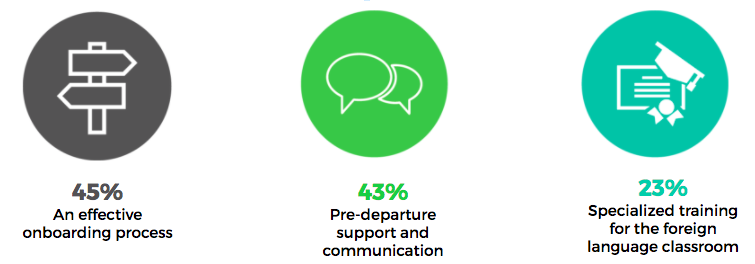Ash Pugh, Director of Operations at Teach Away
In part three of our four-part series, we look at the second part of the recruitment, onboarding and retention cycle: onboarding.
Recruitment is just the beginning
Once you’ve signed a candidate you love, your work is done, right? Not necessarily. The truth is, your work has only just begun. At Teach Away, the average lead time between a candidate accepting an offer and their start date is 123 days – that’s plenty of time for new hires to get cold feet.
We asked our teachers to identify the way schools can help them adjust to their new environment:

Source: Teach Away, International Education Recruitment Report 2017-2018. Download the complete report at www.teachaway.com/report.
They need pre-departure support
As community builders, you need a pre-onboarding program to get your new hires comfortable and invested in their new role and environment.
By doing so, you’re not just more likely to avoid dropouts before candidates start. You’re also setting the stage for prolonged happiness when your new hires ultimately arrive at your school.
1. Make new hires feel like part of your school community.
Personal touches, such as setting up their school email address so they receive communications and can engage with the community, or sending them a t-shirt with your school logo, can go a long way towards making new hires feel welcome and engaged.
2. Prepare new hires for life in their new surroundings.
New teachers undoubtedly have questions about what life will be like when they arrive at their new home. You can alleviate a lot of anxiety on their part by making a concerted effort to prepare new hires for life abroad.
Look into creating opportunities for existing staff to share their experiences with incoming staff. You could try hosting themed webinars run by current staff to share ideas about what entertainment options are available in your location, activities for families, what affairs to get in order at home before you leave or tips and tricks to help get set up when you arrive.
You could also set up groups for incoming and outgoing staff to interact. Facilitating the passing on of rental homes, sale of cars or furniture, or even just providing a way for a new teacher to find out how to bring their beloved pet with them can be of great assistance to both incoming and outgoing staff.
3. Have an effective onboarding process in place.
We’ve seen that international schools with a comprehensive onboarding process experience a significantly reduced likelihood of attrition within the first few months, compared with schools with a weaker – or nonexistent – onboarding process.
As recent hire turnover continues to be a significant issue for many international schools worldwide, having a structured onboarding process cannot be overlooked. The first days, weeks and even months can often determine whether a teacher decides to stay at your school long term.
Onboarding isn’t just about the practical elements of the job that need to be taken care of – securing a work visa, signing the paperwork and outlining professional duties. It’s about facilitating a “soft landing” and making a teacher (and their family) feel safe and comfortable in their new school and location.
4. Take the shock out of culture shock.
Culture shock can have a profound impact on new hires. You need to be aware of the effect it can have on new teachers and be sure to talk to them about it.
The support of peers who’ve been through the same thing and felt the same way they’re feeling cannot be understated. And remember that culture shock doesn’t only kick in at the beginning of the year, so ensure your efforts are sustained to account for the ups and downs that your new teacher hire will experience throughout the year.
5. Foster relationships among your teaching staff.
As we see from Rainer Strack’s research, employees value good relationships with colleagues and their superiors.
Knowing this, you should ensure you’re establishing and maintaining relationships with new employees. You should also provide opportunities, both inside and outside the school, for new teachers to build relationships with their colleagues.
This could take the form of formailized social events or creating a teacher-led social committee to schedule informal gatherings that allow colleagues to connect.
Check back next week for part four where we look at the third part of the recruitment, onboarding and retention cycle: retention.
This article originally appeared in the Spring 2018 edition of InterED, the bi-annual newsletter of the Association for the Advancement of International Education (AAIE).

